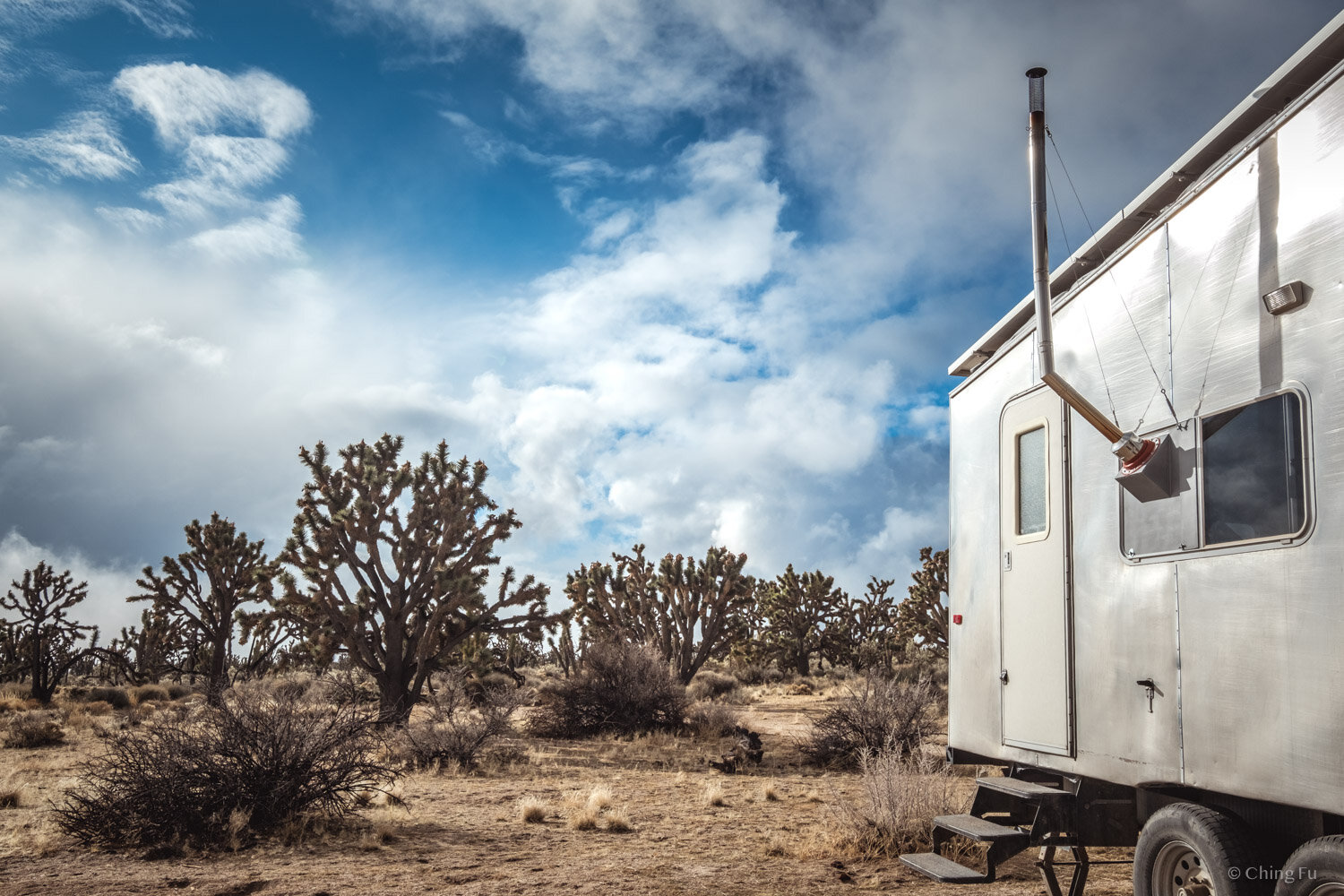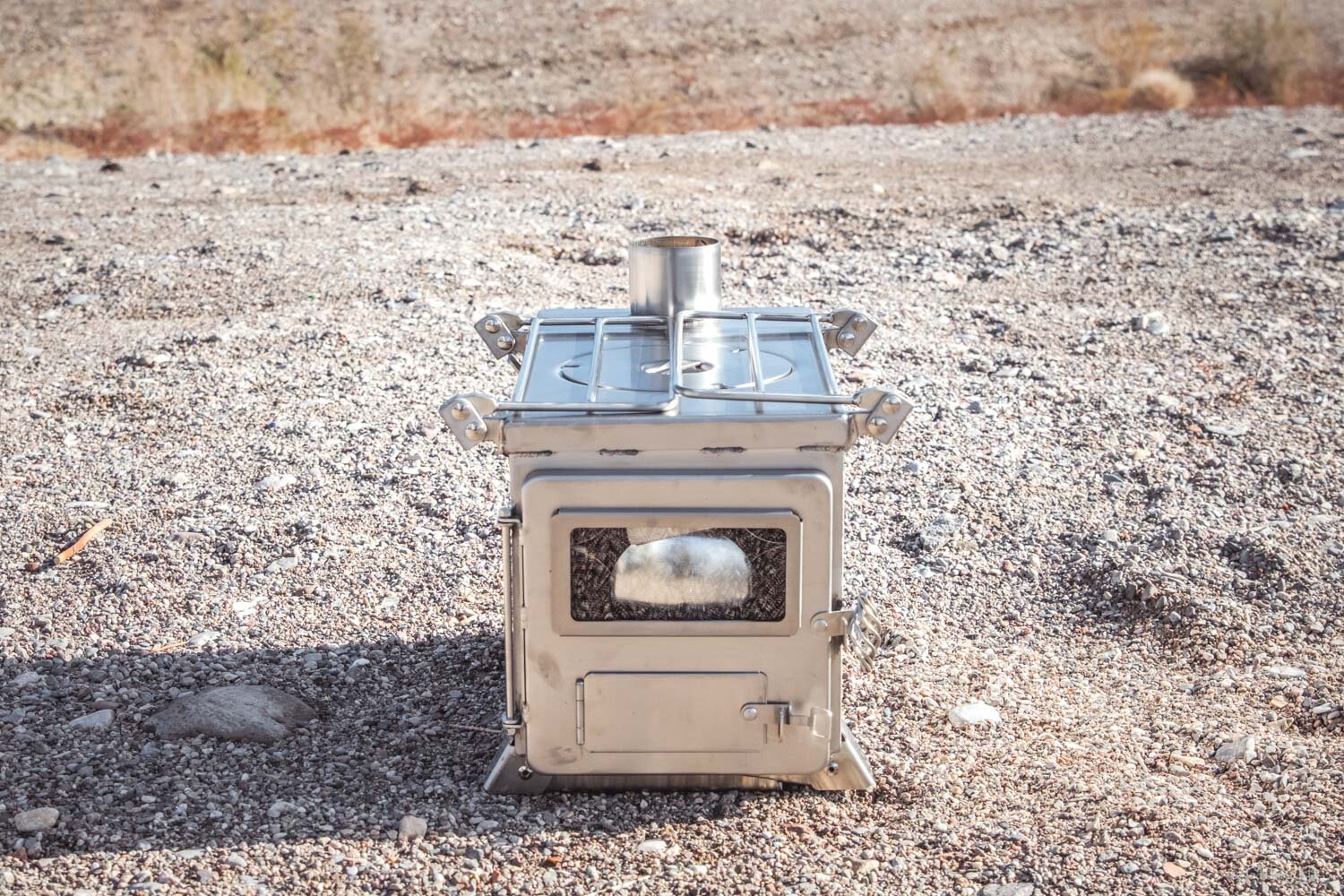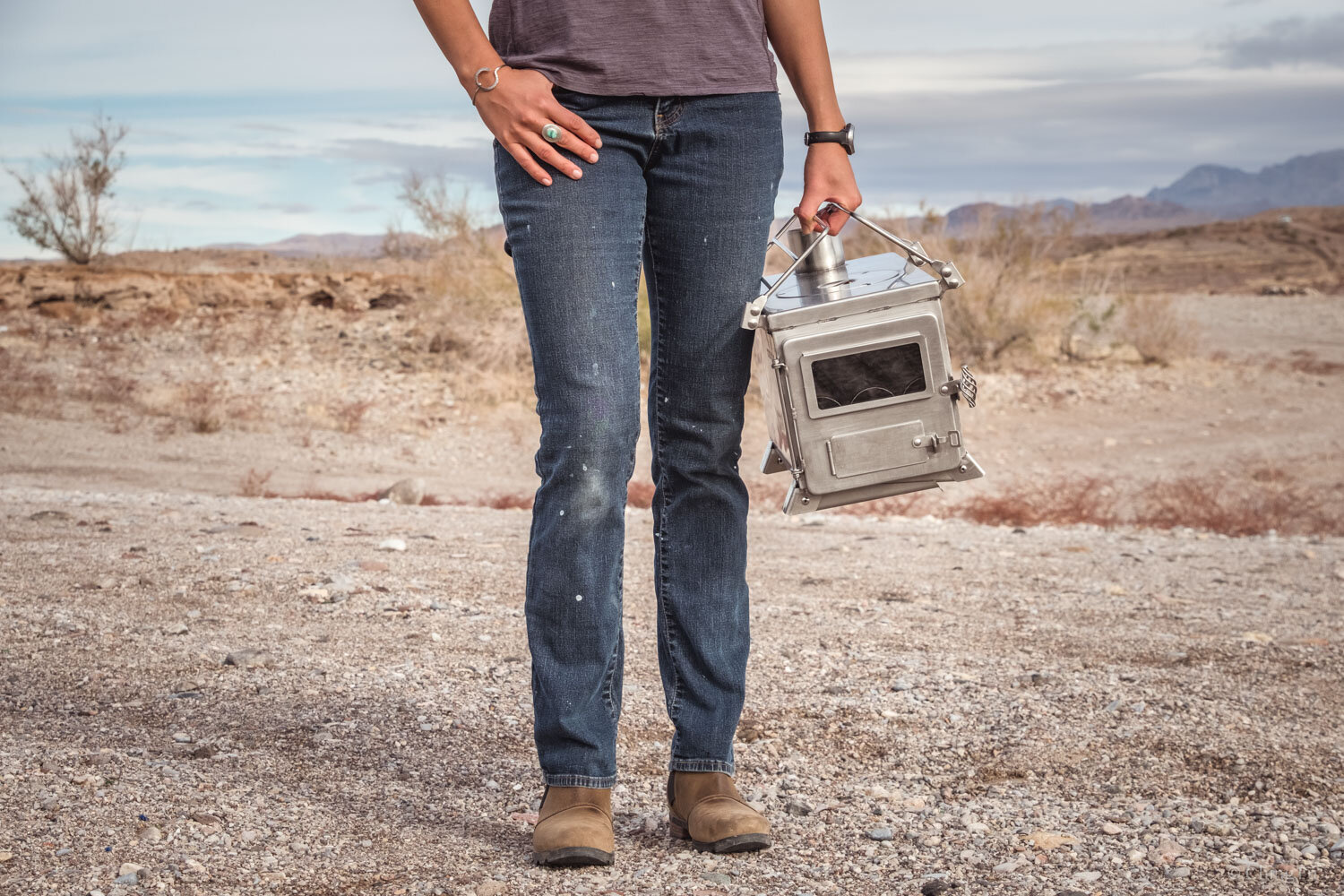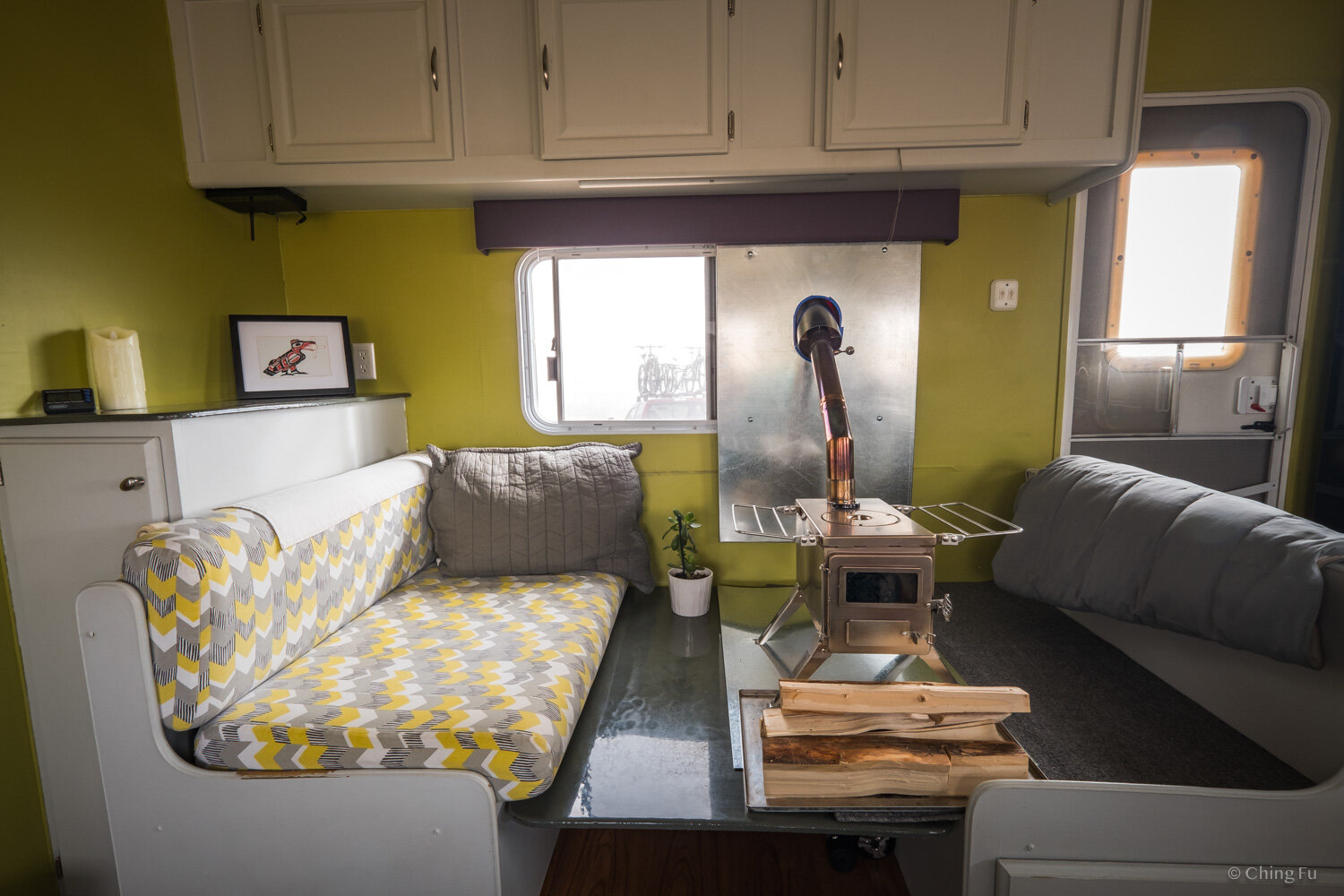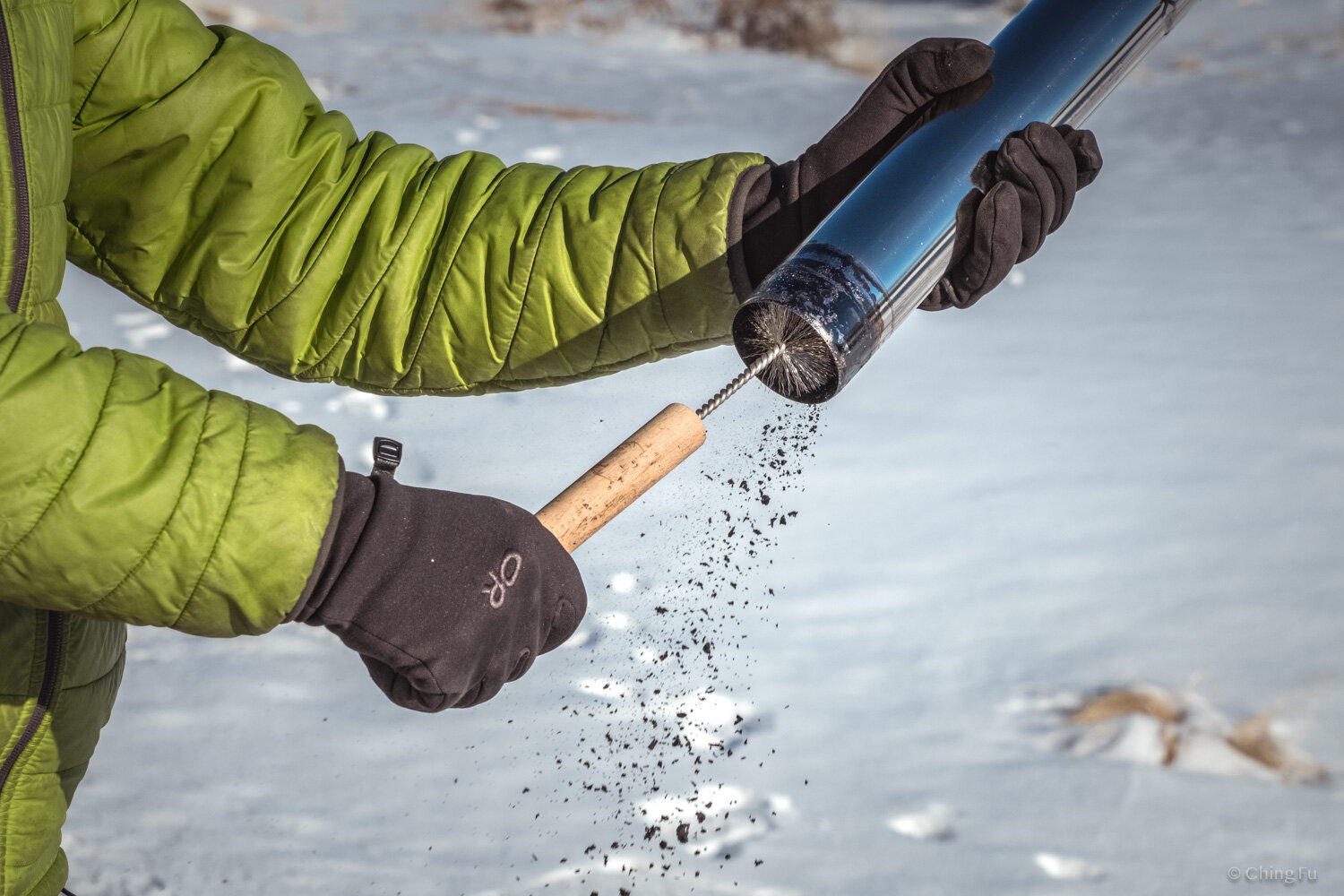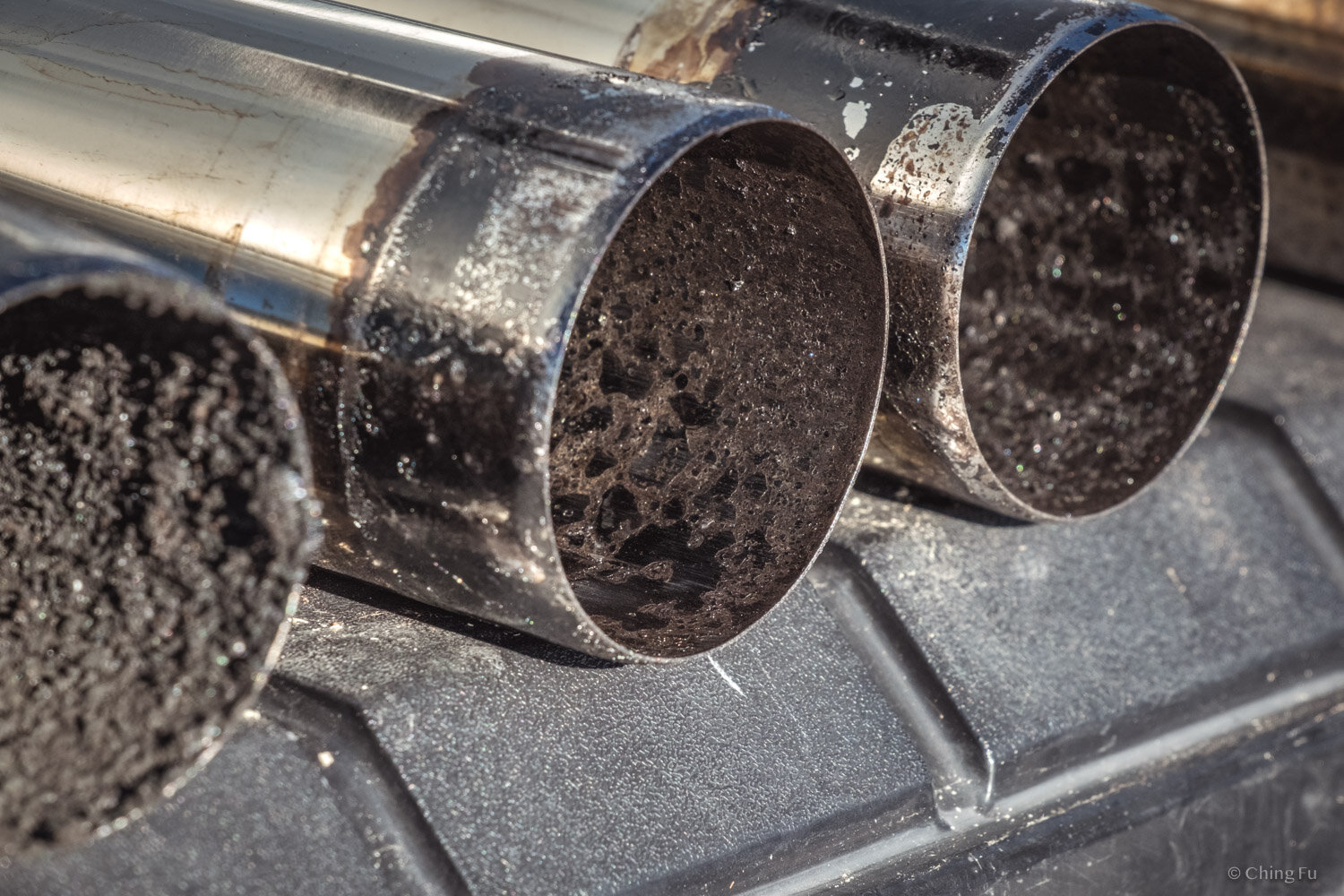Why We Chose The Winnerwell Portable Tiny Wood Stove
Disclosure: The companies mentioned did not sponsor us. But this post contains Amazon affiliate links. As an Amazon Associate, we earn a small commission at no additional cost to you. Please read our disclaimer.
We built the Toaster to use electricity for space heating, using built-in floor heaters and plug-in space heaters. But even with clear desert skies the sun stays too low and sets too soon for us to run those heaters off solar power in the winter.
Outside view of the Toaster with the Winnerwell stove set up inside.
This past November we finally decided it was time to find an alternative source of heat compatible with our goal of being fossil fuel free (no propane, gas, or diesel). The (only) option was a wood stove. I’ve wanted one since we first started rebuilding the rig, but forvarious reasons we (ahem, Jerud) decided against installing one in the Toaster. It’s something we both regret because now we’re locked into a layout with no good place to install a permanent stove.
Then last winter, fed up with the cold, we started searching again and Jerud found Winnerwell. It’s a wood stove specifically made to be portable. It’s actually meant to be used in shelters like canvas tents, teepees, and yurts -- “recreational shelters and general outdoor use.” While the website states that it can also be used in tiny homes and vans, Winnerwell isn’t as popular for those uses as other brands such as Tiny Wood Stove and Cubic Mini Wood Stoves.
The medium size Winnerwell Nomad wood stove.
Reasons We Chose The Winnerwell Wood Stove
But their Nomad model stove was a really attractive option for us because it’s:
Portable: Since we don’t have a space we can dedicate to a wood stove year-round, we need something that can easily be put away when we’re traveling, during warmer months, and doesn’t take up a lot of space when stored.
Affordable: The Winnerwell Nomad stove is $200+ less than then the next cheapest wood stove of a similar size. And unlike most other wood stove companies, the price includes the flue (although we did have to buy some additional parts to work with our setup).
Lightweight: The Nomad stove also weighs a lot less than most other wood stoves because it’s meant to be portable, so is made of thin 304 stainless steel. The medium size we bought (15” x 7.9” x 8.3”) weighs 20.9 lbs – including the flue – compared to the Cubic Mini Wood Stove CB-1008 CUB (11” x 12” x 10.5) which is 25 lbs or the Tiny Wood Stove 3kw Lite (17” x 10.25” x 8.5”) which is 55 lbs (stove only).
The Winnerwell stove is lightweight and portable.
Additional perks of the Winnerwell stove:
It’s a good-looking stove, sleek and modern.
It’s well designed, with collapsible legs and folding shelves that double as carrying handles.
The stove is a lot deeper than other tiny wood stoves. This means we don’t have to cut all our wood into tiny pieces. We also think the larger firebox means we can load more wood, so we don’t have to feed it as frequently as other stoves. (We don’t know if this is true for sure, since we’ve never used another tiny wood stove, and it still needs feeding pretty often.)
We’re hopeful that we can also use it in the shuttle – where we have a lot less space than the Toaster.
Based on all that, we decided it was worth giving the Winnerwell stove a try, even though there wasn’t much information about other nomads using it. We got the Nomad stove in a medium size because the seller, Springbar, said it would be sufficient to heat up our 200 sq. ft space.
It arrived in late November 2019 and our first impressions of the stove were very positive. The company recommends doing a test burn outside before using it inside for two reasons:
To figure out and practice how to use the stove.
To burn off the residues from manufacturing so it doesn’t make the living space smell.
This was the test burn we did after getting the stove.
The Good & The Bad
Here are our thoughts after using the stove on and off over the course of a few months:
The Good:
We’re really happy with it overall. It’s pretty much what we expected. It’s well-made and actually looks as good in person as it does in photos. The “patina” described on the website really does enhance its look.The stove really doesn’t weigh much at all! It’s made of 1/16” thick 304 stainless steel for the body and 1/8” thick for the cooktop. While other stoves are made of steel, cast iron, or vermiculite brick.
The flue sections that come with the stove can actually be stored inside the firebox, minimizing the space it takes to store in our basement.
The cooktop is a wide enough to cook on with a pot or cast iron pan.
The Winnerwell stove set up inside the Toaster.
This isn’t really good or bad, but since the stove doesn’t use a secondary combustion (which unfortunately make it less eco-friendly) the flue has to be cleaned out more frequently than stoves that do have it. Since it’s portable, by the time we’re storing the stove away is probably time for the flue to be cleaned out anyways.
The Bad:
The stove isn’t airtight – we think so that the thinner material doesn’t warp from the heat. if it’s super windy outside, it will cause a backdraft and smoke will blow out of the seams, cooktop lid, and stove door. This requires keeping the stove at “max” so it draws hard enough to fight the wind, but this can make it really hot inside! I have no idea if other tiny wood stoves have this problem.
I wish the stove didn’t have a lid on the cooktop. I know the purpose of the lid is that it can be removed if more heat is needed to cook. But I really wish they offered a model that doesn’t have the lid at all. All it does is let smoke seep through whenever it gets overly smoky inside the stove.
The three issues above have made the inside of the Toaster insanely smoky at times. There’s definitely been a learning curve to using the stove: how much the flue should be opened when adding new wood, where’s the best spot inside the stove to put the wood, and the best temperature to keep the stove at. We added an aftermarket wood stove thermometer which helped tremendously in managing the stove.
Sometimes, water will drip down the inside of the flue and out of the backend of the stove when it’s raining outside, when the stove is off.
The medium size stove is just an inch shorter than standard 16” split wood! This means we still have to saw down much of the wood we buy. Sometimes it’s short enough, and sometimes we can put longer pieces in diagonally. But Jerud wishes we had gotten the large size stove because it’s a few inches longer inside.
The glass in the door is a really nice. But it’s always sooty because the stove doesn’t have an air wash. The trick to keep the window clean is to keep the wood near the back of the stove.
The Winnerwell stove is really only meant to burn seasoned wood whereas other stoves are more flexible in the fuels they can use. This hasn’t been an issue for us yet, but finding quality, sustainable, dry wood isn’t always easy.
Cost Of The Winnerwell Nomad Wood Stove & Parts
Not including materials we needed to install the wood stove in our rig, we spent:
Winnerwell Nomad medium-size stove (flue included): $349.00
Two 45-degree flue pipe sections: $39.90 (for both)
Double wall pipe section: $59.95
Flue cleaning brush: $19.95
Totaling: $468.80 (tax not included)
We’ve stored the stove away since the weather has warmed up, but we definitely look forward to using it again once winter’s back! It’s let us comfortably stay in several places we might’ve not stuck around when the weather got bad. It’s so nice to have a toasty living space, a place to dry wet clothes, and an alternative heating water/cooking option for those long, dreary winter spells with very little solar power.
We weren’t expecting it to snow when we arrived Mojave National Preserve. But we decided to stick around for it (the best decision) and our wood stove made those few freezing days so much fun!

